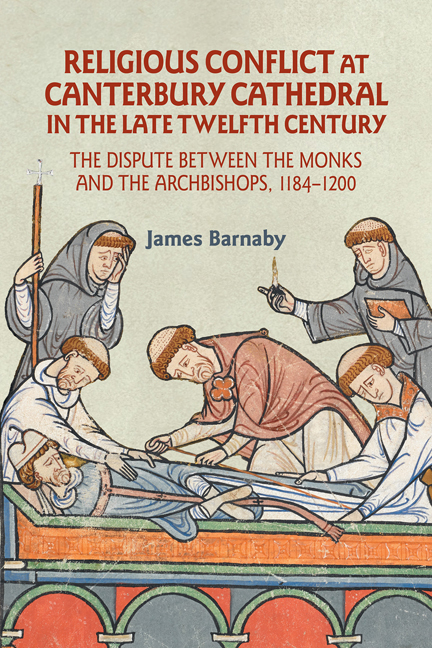 Religious Conflict at Canterbury Cathedral in the Late Twelfth Century
Religious Conflict at Canterbury Cathedral in the Late Twelfth Century Book contents
- Frontmatter
- Dedication
- Contents
- List of Maps
- Acknowledgements
- List of Abbreviations
- Introduction
- 1 The Canterbury Dispute in the Sources
- 2 Baldwin's Grand Plan (1184–November 1186)
- 3 To Rome (November 1186–July 1187)
- 4 The Hackington Dispute (August 1187–September 1189)
- 5 A New King, A Crusading Archbishop, and A Temporary Peace (September 1189–August 1191)
- 6 A New Primate (1191–3)
- 7 The Dispute Renewed (1193–1200)
- 8 After Lambeth: The Dispute in Later Centuries
- Conclusion
- Appendices
- Timeline
- Select Bibliography
- Index
- Other volumes in Studies in the History of Medieval Religion
7 - The Dispute Renewed (1193–1200)
Published online by Cambridge University Press: 09 May 2024
- Frontmatter
- Dedication
- Contents
- List of Maps
- Acknowledgements
- List of Abbreviations
- Introduction
- 1 The Canterbury Dispute in the Sources
- 2 Baldwin's Grand Plan (1184–November 1186)
- 3 To Rome (November 1186–July 1187)
- 4 The Hackington Dispute (August 1187–September 1189)
- 5 A New King, A Crusading Archbishop, and A Temporary Peace (September 1189–August 1191)
- 6 A New Primate (1191–3)
- 7 The Dispute Renewed (1193–1200)
- 8 After Lambeth: The Dispute in Later Centuries
- Conclusion
- Appendices
- Timeline
- Select Bibliography
- Index
- Other volumes in Studies in the History of Medieval Religion
Summary
The start of Hubert's archiepiscopate was a peaceful period for the Canterbury monks. With no further mention of the planned church at Lambeth and the community left to tend to their own affairs, it appeared as though the archbishop did not plan to pursue his predecessor's dream. Yet Hubert had the same problem as Baldwin: how to provide for the clerks of his household. This was the same problem bishops at other sees were facing. Hugh of Coventry solved this by expelling the cathedral monks and installing canons (albeit temporarily). The bishops of Bath, rather than reforming their cathedral chapters, tried to gain control of Glastonbury abbey, thereby increasing their income. At Canterbury, a collegiate church was still a sensible answer, being less contentious than evicting the cathedral monks or trying to take over another local monastery. As Baldwin's friend and executor of his will, Hubert had a personal interest in seeing the plan fulfilled. The reason Lambeth was not mentioned immediately after his election was that Hubert was busy dealing with the problems arising from Richard's imprisonment and ransom. Only once these had been settled could he revive Baldwin's plan.
Lambeth Revived
In 1196, the Lambeth proposal was renewed. Knowing that the monks would still oppose him, Hubert decided to begin by offering a compromise. He suggested that the chapel be built at Maidstone on the conventual estates, thereby giving the monks significant control over the foundation. Like Lambeth, Maidstone was within a day's journey of London, making it a convenient site from which the archbishop's business could be conducted. Hubert had also received permission, in 1195, to hold a weekly market and an annual fair at Maidstone, which might have brought added profits for the foundation were it based there. The monks, however, protested against such a plan. After listening to the monks recount the long history of the conflict, Hubert declared that, while sorry to go against the wishes of the church which had elected him as its head, he could not leave the proposed work unfinished. In April 1196, the king confirmed the exchange between the archbishop and the monks of Rochester, by which Lambeth was obtained in return for the manor of Dartford, the chapel of Helles in Darenth, and property in the vill of Cliffe (Kent).
- Type
- Chapter
- Information
- Religious Conflict at Canterbury Cathedral in the Late Twelfth CenturyThe Dispute between the Monks and the Archbishops, 1184-1200, pp. 153 - 176Publisher: Boydell & BrewerPrint publication year: 2024
